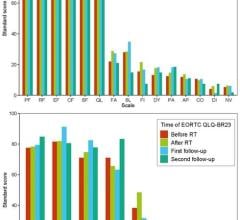
March 13, 2019 — The number of new particle therapy rooms ordered worldwide dropped by almost 20 percent in 2018, according to a new report from MEDraysintell, continuing a trend dating back to mid-2016. The report says this trend may change if particle therapy vendors are able to build a strong order book in 2019 and 2020.
Following the large number of new orders for proton therapy equipment reported worldwide during the year 2015, MEDraysintell considered that it was facing a market with strong potential. This positive trend continued until mid-2016, when it began to slow down with a persistent decline in 2017, further confirmed in 2018 as well. Overall, 2018 sales dropped by 62 percent compared to 2015. This decline impacts directly the particle therapy market size (in value by U.S. dollars) evolution, with an anticipated market slowdown of some 25 percent in 2020 compared to 2018. The year 2018 also clearly confirmed the trend in favor of single-room facilities, with 100 percent of the proton therapy orders worldwide oriented towards single-room facilities (compared to less than 40 percent in 2016).
However, a retrospective analysis shows that 2015 was an exceptional year with a record level of orders, and not the new standard expected by the industry, according to the MEDraysintell report. In general, negative publicity, resistance from health authorities and private insurances to reimburse proton therapy, and cost hurdles as a whole have certainly been important factors in the slow adoption of proton therapy facilities in the recent past, the report said. This limited support from investors and healthcare payers remains unchanged and linked to both the higher price of this modality compared to external radiotherapy and the lack of definitive clinical demonstration of superiority (which is under progress).
As of February 2019, there were fewer than 240 particle therapy (mostly proton therapy) treatment rooms available to patients worldwide. This low number represents only 0.3 particle therapy treatment rooms per 10 million people compared to roughly an equivalent 20 radiotherapy systems in the world.
In order to sustain the market growth and to increase the use of proton therapy as an efficient cancer treatment, the PT industry should encourage the research, collection and ongoing publication of clinical evidence, according to MEDraysintell. In addition, stronger marketing is needed in order to grow the referencing of patients toward proton therapy centers. Some mixed signals from the proton therapy area have already been observed — for instance a growing interest of the medical-scientific community stating that at least 10 percent of the population requiring external radiotherapy treatment could benefit from proton therapy. However, this level reached only 0.7 percent in 2018 and almost all operational particle therapy centers are far from saturation levels, with only 17 percent of them able to treat on average over 200 patients per treatment room.
For more information: www.medraysintell.com
Related Proton Therapy Content
VIDEO: Economics of Proton Therapy
VIDEO: The Role of the Physicist in Proton Therapy
360 View of the Gantry Room at the Northwestern Medicine Chicago Proton Center
360 View of the Inclined Beam Room at the Northwestern Medicine Chicago Proton Center


 March 28, 2024
March 28, 2024 








